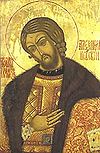- Nikolay Dollezhal
-
Nikolay Dollezhal Born March 3, 1914
Zaporizhia Oblast, Russian Empire, Present-day UkraineDied November 20, 2000 (aged 101) Citizenship Soviet Union
RussiaNationality Ukrainian Fields Mechanical Engineering Institutions Institute of Chemical Physics
Moscow State University
Sternberg Astronomical InstituteAlma mater Bauman Moscow State Technical University Known for Soviet atomic bomb project
Founder of the RBMK type nuclear reactor
nuclear marine propulsionNotable awards Order of Merit for the Fatherland
Hero of Socialist LabourNikolay Antonovich Dollezhal (October 27, 1899 – November 20, 2000)[1] was a Soviet mechanical engineer, a key figure in Soviet atomic bomb project and chief designer of nuclear reactors from the first plutonium production reactor to the RBMK.
Born in Omelnik, Zaporizhia Oblast, Dollezhal graduated MVTU in 1923. Until 1930, he worked in various design bureaus, but after a tour of Europe in 1929 was arrested and spent a year and a half in prison, before being acquitted in January 1932. In 1932-1943 he headed important manufacturing plants in Kiev, Leningrad and Sverdlovsk.
In 1943, Dollezhal was appointed to lead the new Institute of Chemical Machinery in Moscow. In 1946, the Institute was assigned to the Soviet atomic project; his first reactors, graphite moderated types A and AI, produced Soviet plutonium used in Joe 1 nuclear test of 1949 and subsequent nuclear weapons deployment. After 1950, Dollezhal focused on nuclear marine propulsion. His first proposal, Type AM, was not practical for marine uses but became the core of the first nuclear power plant in Obninsk, commissioned in 1954. In the same year, he produced a viable draft of a light water submarine reactor.
Dollezhal pioneered the concept of the pressurized water reactor, which led to numerous military and VVER-type civilian designs. In 1957 Dollezhal Institute launched their first dual-use (civilian energy and weapons-grade plutonium) powerplant, Type EI, and seven years later, the first truly industrial Beloyarsk power plant. All subsequent Soviet reactors (VVER, RBMK) also originated from his firm.
Honours and awards
- This article incorporates information from the equivalent article on the Russian Wikipedia.
- Lenin Prize (1957)
- Three Stalin Prizes (1949, 1952 and 1953)
- Two USSR State Prizes (1970 and 1976)
- Hero of Socialist Labour, twice (1949 and 1984)
- Six Orders of Lenin (incl 1949 and 1984)
- Order of the October Revolution
- Order of the Red Banner of Labour
- Order of the Red Star
- Order of Merit for the Fatherland, 2nd class (1999)
- Kurchatov Gold Medal (Russian Academy of Sciences, 2000)
References
- ^ "Nikolay A. Dollezhal". Brief History. N.A. Dollezhal Research and Development Institute of Power Engineering. http://www.nikiet.ru/eng/history/dollezh.html. Retrieved 2008-05-11.
People from Russia Leaders and religious - Pre-1168
- 1168–1917
- 1922–1991
- 1991–present
- RSFSR leaders
- General secretaries
- Soviet premiers (1st deputies)
- Soviet heads of state (and their spouses)
- Prime ministers (1st deputies)
- Foreign ministers
- Prosecutors general
- Metropolitans and patriarchs
- Saints

Military and explorers - Field marshals
- Soviet marshals
- Admirals
- Aviators
- Cosmonauts
Scientists and inventors - Aerospace engineers
- Astronomers and astrophysicists
- Biologists
- Chemists
- Earth scientists
- Electrical engineers
- IT developers
- Linguists and philologists
- Mathematicians
- Naval engineers
- Physicians and psychologists
- Physicists
- Weaponry makers
Artists and writers Sportspeople - Chess players
Categories:- 1899 births
- 2000 deaths
- Soviet nuclear physicists
- Russian centenarians
- Nuclear weapons program of the Soviet Union
- Soviet physicists
- Heroes of Socialist Labour, twice
- Recipients of the Order of Merit for the Fatherland, 2nd class
- Lenin Prize winners
- Stalin Prize winners
- USSR State Prize winners
- Recipients of the Order of Lenin, five times
- Recipients of the Order of the October Revolution
- Recipients of the Order of the Red Banner of Labour
- Recipients of the Order of the Red Star
- Russian inventors
Wikimedia Foundation. 2010.
